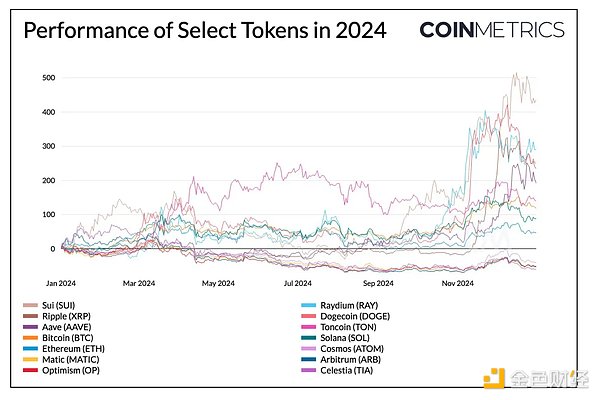
Author: Tanay Ved, Cooper Duschang Source: Coin Metrics Translation: Shan Oppa, Golden Finance
Introduction2024 is a landmark year for the digital asset industry, starting with the long-awaited approval of a spot Bitcoin ETF and ending with the U.S. presidential election. Institutional capital enters the market, driving Bitcoin prices to new highs and fueling the growth of the entire ecosystem. Stablecoins surged to over $200 billion, tokenization of risk assets gained momentum, and corporate demand for Bitcoin accelerated at an unprecedented rate. Bitcoin experienced its quadrennial halving, Ethereum expanded in blobs, and Solana’s ecosystem expanded rapidly. Meanwhile, old stories fade away to make way for emerging themes.
Not long ago, the cryptocurrency industry faced strict scrutiny from the U.S. Securities and Exchange Commission and an uncertain interest rate hike cycle. Now, optimism is back. Bitcoin surged to over $100,000 post-election on the back of renewed enthusiasm in a pro-crypto America and across the ecosystem. These developments position the industry on a solid footing as we move towards 2025, ready to explore the transformative trends and opportunities ahead.
Market Outlook Assets, Themes and SectorsOutlook: Through 2025, we expect selective outperformance in emerging and mature categories, such as Tier 1 Decentralized Finance (DeFi) on blockchain, Ethereum, Solana and Base, and the evolving intersection of cryptocurrency and artificial intelligence.
Bitcoin (BTC)
< em>Outlook: Bitcoin (BTC) will test the $140,000 to $170,000 price range in 2025, supported by cyclical growth trends and accelerating structural adoption. Continued inflows into ETFs, corporate funding adoption, and potential adoption against the backdrop of reduced supply will drive demand for BTC.
Ethereum (ETH)
< em>Outlook:Ethereum’s lackluster performance will disappear as the ETH/BTC ratio reverses to 0.055. usEthereum (ETH) is expected to reach a price range of $7,500-$10,000, driven by increased institutional demand, maturation of the Layer 2 ecosystem, and Ethereum’s continued dominance in stablecoins, RWA tokenization, and DeFi. .
Airdrop TrendOutlook : While airdrops may continue to disappoint speculators in 2025, a new round of airdrops and an adjusted distribution structure and process may allow more satisfied users to be rewarded for participating.
Industry exchange-traded funds (ETF)Outlook: With the relaxation of the regulatory environment after the new administration, the digital asset field will become clearer , we expect broader institutional participation to sustain significant inflows into U.S. spot Bitcoin ETFs. Assets under management (AUM) are expected to more than double, with Bitcoin holdings reaching over 2.5 million BTC by 2025.
Infrastructure Layer 12025 Outlook: The Layer 1 technology landscape will move beyond EVM, and as base layer and scaling solutions continue to advance, demand for block space will revolve around EVM, Ethereum and Solana ecosystems are integrated. “Tier 1 premiums” will remain strong.
Layer 2Outlook: Blob space will be in Ethereum Scalability plays an increasingly important role. As more institutional (Ink Chain, Soneium) and custom (Unichain) layer 2 are built on Ethereum, expect Blob fees to make up a larger proportion of the total fees paid on Ethereum.
Layer-2 will need to continue to monitor its blob inclusion due to plans to increase the target blob rate in Ethereum's Pectra upgrade , while ensuring costs are minimized relative to alternative data availability solutions.
Applying Stablecoins
Outlook #1: Stablecoins grow in 2024 About 50%, more than 200 billion US dollars, and the total transfer volume exceeds 12 trillion US dollars. We expect stablecoin supply to exceed $400 billion in 2025, driven by a bull market, issuer entry and network expansion, passage of stablecoin legislation, and adoption of consumer and enterprise payments and financial services, with settlement volume growing by more than 200,000 billion dollars.
Outlook #2: USDT and USDC are likely to maintain their status as the top two stablecoins in 2025, exceeding their 2024 growth rates and maintaining market dominance. However, “other” stablecoins – driven by new issuances and the growth of existing alternatives – are expected to close the gap in total supply and take an increasing share of the stablecoin market (~30%) .
Tokenization of Real World Assets (RWA)
Outlook: As the regulatory environment evolves and institutions seek more accessible access to capital and liquidity trajectories, we expect tokenized assets to flood into major blockchains. As a result, RWA market assets entering the public blockchain orbit will double. We expect at least one company listed on the New York Stock Exchange or Nasdaq to tokenize its stock on the blockchain.
Conclusion
Although entering 2025, the There is a lot of positive momentum, but it must be acknowledged that certain macroeconomic and cryptocurrency-specific risk factors remain. Inflation, while better than before, is still hard to eliminate, and the Big Seven’s revenue slowdown could have a knock-on effect on the cryptocurrency industry. Unique factors such as pro-crypto regulations failing to take shape as expected and a reversal of MicroStrategy's Bitcoin accumulation strategy could create headwinds in 2025. Therefore, we remain cautiously optimistic about the year ahead.










